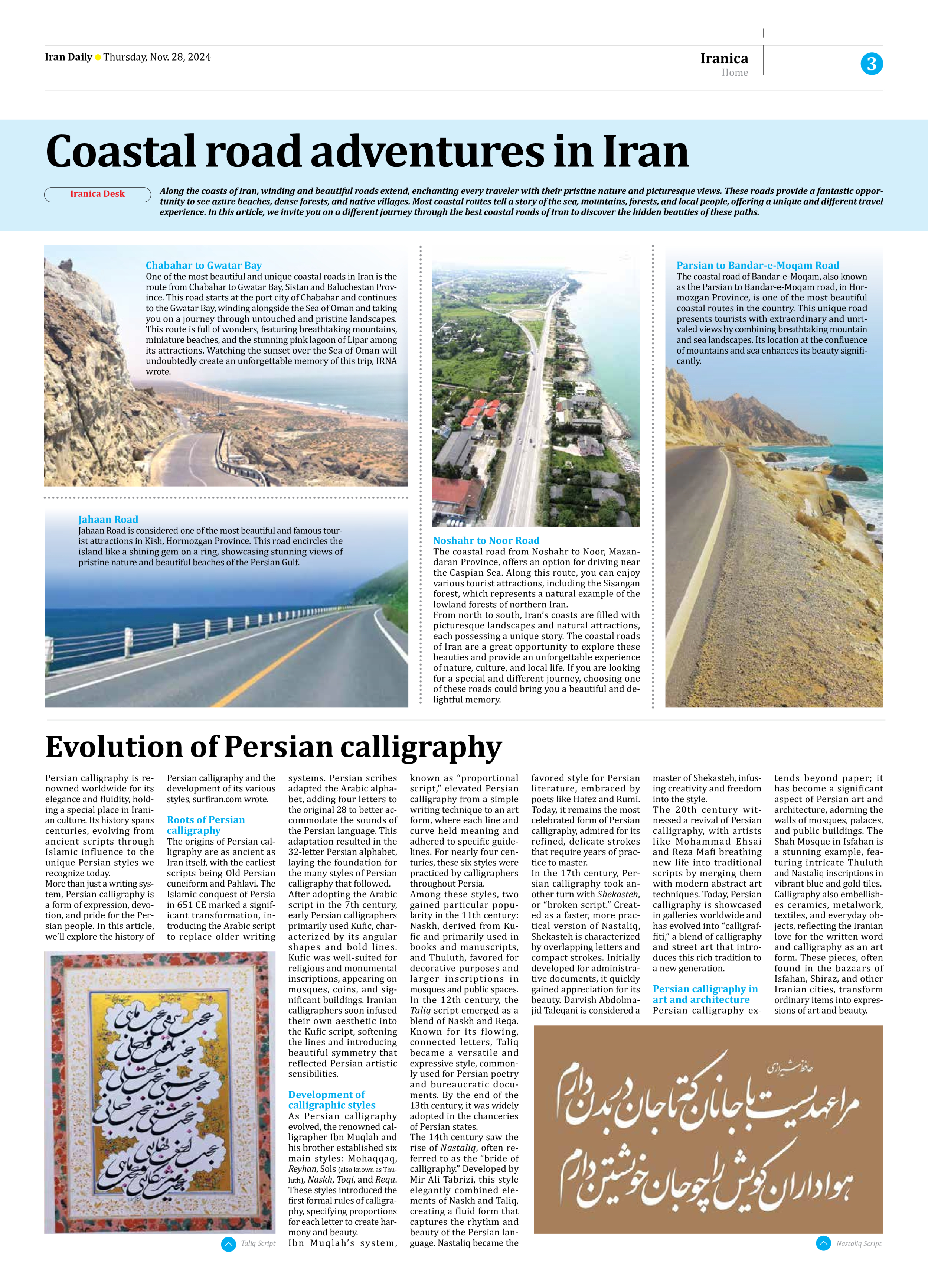
Evolution of Persian calligraphy
Persian calligraphy is renowned worldwide for its elegance and fluidity, holding a special place in Iranian culture. Its history spans centuries, evolving from ancient scripts through Islamic influence to the unique Persian styles we recognize today.
More than just a writing system, Persian calligraphy is a form of expression, devotion, and pride for the Persian people. In this article, we’ll explore the history of Persian calligraphy and the development of its various styles, surfiran.com wrote.
Roots of Persian calligraphy
The origins of Persian calligraphy are as ancient as Iran itself, with the earliest scripts being Old Persian cuneiform and Pahlavi. The Islamic conquest of Persia in 651 CE marked a significant transformation, introducing the Arabic script to replace older writing systems. Persian scribes adapted the Arabic alphabet, adding four letters to the original 28 to better accommodate the sounds of the Persian language. This adaptation resulted in the 32-letter Persian alphabet, laying the foundation for the many styles of Persian calligraphy that followed.
After adopting the Arabic script in the 7th century, early Persian calligraphers primarily used Kufic, characterized by its angular shapes and bold lines. Kufic was well-suited for religious and monumental inscriptions, appearing on mosques, coins, and significant buildings. Iranian calligraphers soon infused their own aesthetic into the Kufic script, softening the lines and introducing beautiful symmetry that reflected Persian artistic sensibilities.
Development of calligraphic styles
As Persian calligraphy evolved, the renowned calligrapher Ibn Muqlah and his brother established six main styles: Mohaqqaq, Reyhan, Sols (also known as Thuluth), Naskh, Toqi, and Reqa. These styles introduced the first formal rules of calligraphy, specifying proportions for each letter to create harmony and beauty.
Ibn Muqlah’s system, known as “proportional script,” elevated Persian calligraphy from a simple writing technique to an art form, where each line and curve held meaning and adhered to specific guidelines. For nearly four centuries, these six styles were practiced by calligraphers throughout Persia.
Among these styles, two gained particular popularity in the 11th century: Naskh, derived from Kufic and primarily used in books and manuscripts, and Thuluth, favored for decorative purposes and larger inscriptions in mosques and public spaces.
In the 12th century, the Taliq script emerged as a blend of Naskh and Reqa. Known for its flowing, connected letters, Taliq became a versatile and expressive style, commonly used for Persian poetry and bureaucratic documents. By the end of the 13th century, it was widely adopted in the chanceries of Persian states.
The 14th century saw the rise of Nastaliq, often referred to as the “bride of calligraphy.” Developed by Mir Ali Tabrizi, this style elegantly combined elements of Naskh and Taliq, creating a fluid form that captures the rhythm and beauty of the Persian language. Nastaliq became the favored style for Persian literature, embraced by poets like Hafez and Rumi. Today, it remains the most celebrated form of Persian calligraphy, admired for its refined, delicate strokes that require years of practice to master.
In the 17th century, Persian calligraphy took another turn with Shekasteh, or “broken script.” Created as a faster, more practical version of Nastaliq, Shekasteh is characterized by overlapping letters and compact strokes. Initially developed for administrative documents, it quickly gained appreciation for its beauty. Darvish Abdolmajid Taleqani is considered a master of Shekasteh, infusing creativity and freedom into the style.
The 20th century witnessed a revival of Persian calligraphy, with artists like Mohammad Ehsai and Reza Mafi breathing new life into traditional scripts by merging them with modern abstract art techniques. Today, Persian calligraphy is showcased in galleries worldwide and has evolved into “calligraffiti,” a blend of calligraphy and street art that introduces this rich tradition to a new generation.
Persian calligraphy in art and architecture
Persian calligraphy extends beyond paper; it has become a significant aspect of Persian art and architecture, adorning the walls of mosques, palaces, and public buildings. The Shah Mosque in Isfahan is a stunning example, featuring intricate Thuluth and Nastaliq inscriptions in vibrant blue and gold tiles.
Calligraphy also embellishes ceramics, metalwork, textiles, and everyday objects, reflecting the Iranian love for the written word and calligraphy as an art form. These pieces, often found in the bazaars of Isfahan, Shiraz, and other Iranian cities, transform ordinary items into expressions of art and beauty.







